SD › Italy › Milan › Best Museums
Updated: April 28, 2022
By Santorini Dave
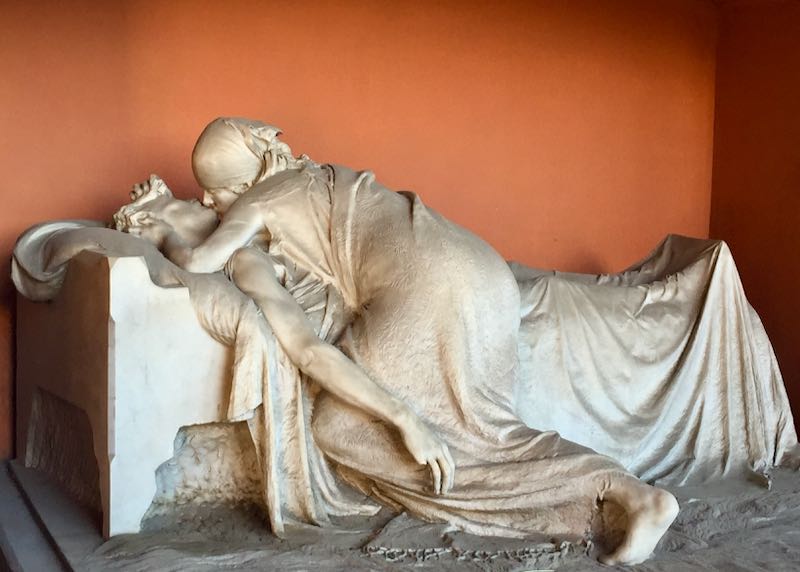
Milan is a great city for museum-goers, and offers many rewards for those who have the time to explore. Must-sees include Da Vinci’s famous Last Supper and the impressive collection housed in the Pinacoteca diBrera. After that, it gets highly subjective. Fans of classical and modern art, paintings and sculpture, and history and architecture will have their choice. The five on this list are really just a starting place as Milan has treasures worth seeing regardless of your personal taste.
Best Milan Museum Tours
- Best of Milan Tour with Last Supper and Skip-the-Line Duomo Tickets: Milan Duomo, Sforza Castle (exterior), Brera District. Local, English-speaking guide. 2.5 hours
- Brera District & Pinacoteca Guided Experience: Guided museum tour, also visits local artisan shops in the Brera district. 2 hours
- Sforza Castle & Museums Guided Tour: Explore castle grounds & history, visit the Duke’s apartment, private chapel, and castle chambers. See Michelangelo’s mural and his final sculpture. 2 hours
- Sforza Castle & Ambrosiana Gallery Private Tour: Private tour for up to 6 people visits the courts of the Sforza Castle, Michelangelo’s Pietà, Leonardo’s Fresco and Atlantic Codex, ending in Cathedral Square. 3 hours
- Monumental Cemetery of Milan Guided Tour: Explore the cemetery history and visit significant buildings and burial places within. 1.5 hours
The 5 Best Museums in Milan
1. Cenacolo Vinciano (Last Supper)
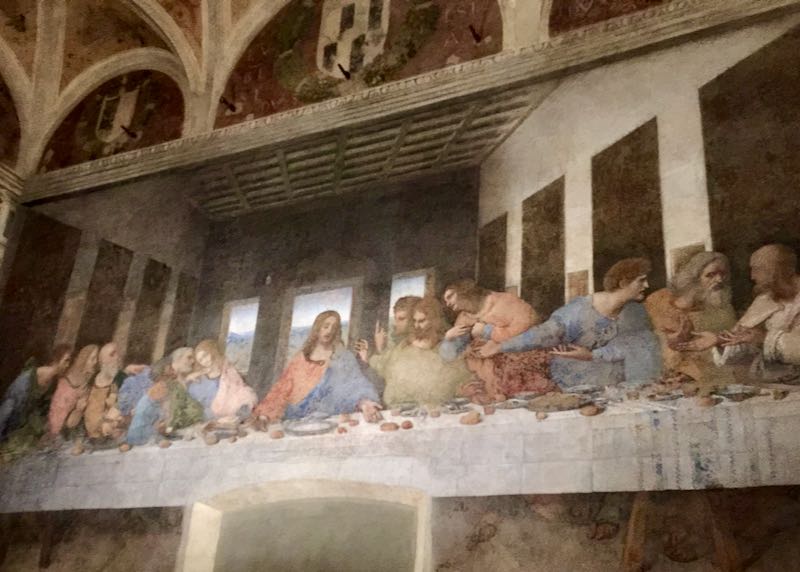
Milan’s most prominent piece of art isn’t actually housed in a museum at all. Leonardo Da Vinci’s famous masterwork is found in the small rectory of the Santa Maria delle Grazie monastery. Created with a combination of oil and egg tempera, it’s amazing the painting has lasted for over 500 years, withstanding botched restorations, careless structural alterations (including a doorway that chopped off part of the painting), and bombing raids that wiped out many surrounding buildings.
Viewings of the Last Supper are tightly managed. Groups of 30 are brought into the small hall that contains the painting for 15-minute blocks of time, then shuttled promptly out for the next group. The entire viewing experience is only 30 minutes (and only 15 in the actual room that contains the painting), but you will likely want to give yourself at least an hour total so you can also explore the piazza outside the rectory.
Buying tickets in advance is a must, and are often hard to find without buying at least a couple months out. Because of the small window of viewing time and the painting’s great artistic and historical merit, we highly recommend seeing the Last Supper as part of a guided tour. Read more about how to buy tickets, book tours, and visit the Last Supper at our post here. Open Tuesday through Sunday from 8am to 7pm, with extended hours on Sundays during the high season (late spring and summer). Closed Mondays • Map
2. Pinacoteca di Brera (The Brera Gallery)
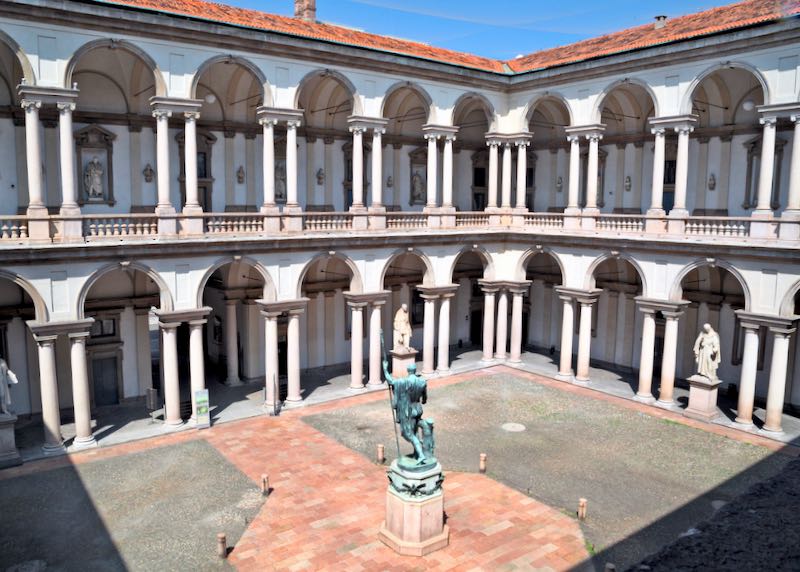
With its collection of paintings ranging from 14th Century classics to the avant-garde, the Pinacoteca di Brera has been Milan’s most prestigious gallery since the time of Napoleon, who intended the museum to house all the finest art from French-conquered lands (which for a time included Milan and much of Italy). Today, the building, known as Palazzo Brera, also houses the Brera Fine Arts Academy along with the museum itself, and students mingle with tourists in the palazzo’s giant courtyard lined with statues (including one of Napoleon himself).
The museum flows chronologically through mostly Italian works, although Flemish artists like Rubens and Van Dyck are also represented. Huge halls open up to large-scale artworks bursting with color and Baroque drama from masters like Caravaggio and Raphael, as well as lesser-known but hugely impressive pieces like “Lamentation of Christ” by Lombardian painter Andrea Mantegna. Must-sees in the museum include Caravaggio’s “Supper at Emmaus” and “Discovery of the Body of St. Mark” by Tintoretto.
The Orto Botanico di Brera, a gorgeous botanical garden, is located right behind the Palazzo. Often missed by tourists, it was used by the Jesuits who once resided in the building to teach herbal medicine. Today it’s a brick-lined oasis with water features, lovelyflower beds, and standsof Ginkgo Biloba trees.Also, fans of beautiful libraries should not miss the Biblioteca di Brera within the Palazzo, which houses nearly 900,000 historical and literary works (although only 40,000 or so of them are viewable).
The Brera Gallery isn’t huge, but it’s large enough that you will need at least 2-3 hours to really take it in. Consider allowing for a longer visit on a nice day, so you can enjoy and explore the open-air courtyard. Entrance is €10 (€7 for students), with audio guides available (in Italian, English, French, Spanish and German) for an additional €5. Coin-operated storage lockers are also available for €1. Open Tuesday to Sunday from 8:30am to 7:15pm (the Ticket Office closes at 6:40pm). Closed Mondays. • Map
3. Musei del Castello Sforzesco (Sforza Castle Museum)
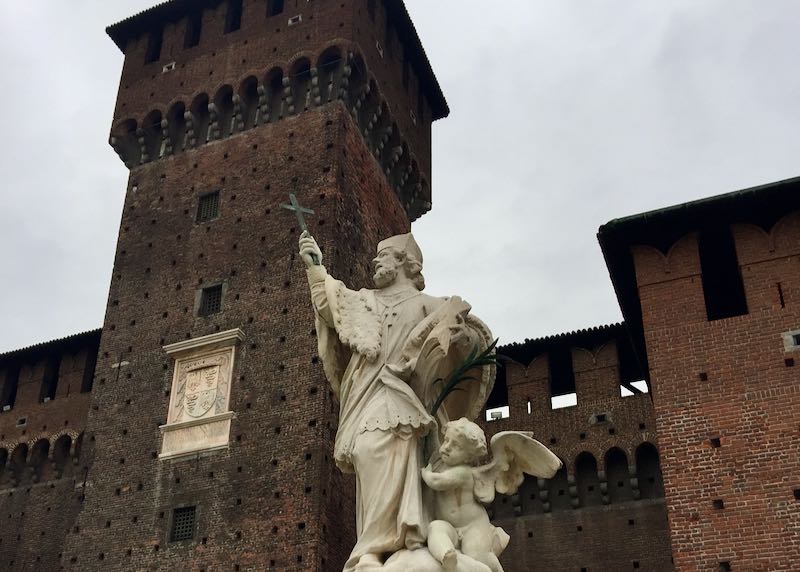
The history of Castello Sforzesco dates back to the 14th Century, when the area upon which it sits acted as a northern fortification of the city, which at that time was ringed with canals that also served as protection from invaders. In the 15th century, the duke of Milan, Francesco Sforza, began construction on the castle, which would continue for another six decades under his son, Galeazzo Maria, and the next duke of Milan, Ludovico Sforza. By the 17th Century it was among the largest fortresses in all of Europe.
Over the centuries the castle has undergone numerous additions, raids, bombings, and reconstructions, housed frescoes painted by Leonardo Da Vinci, and now acts as the entrance to Milan’s largest park, Parco Sempione. The vast structure is now home to numerous museums, the most notable of which is the Pinacoteca del Castello Sforzesco, which contains works ranging from religious paintings of the 15th and 16th Centuries to more secular pieces from Canaletto and Tintoretto. Other museums in the complex include one devoted to ancient art, an archeological museum with pieces taken from the nearby Civico Museo Archeologico di Milano, and the Musei del Rondanini Pieta, which features the last sculpture ever created by Michelangelo.
Taken together, the castle and its museums arguably represent the best way to learn about Milan, as the structure and the works of art it houses are a record of the city’s tumultuous history and culture over the centuries. The grounds and the museums inside are captivating even without the deeper context, but a guided tour is highly recommended for those interested in getting the most out of the experience.
Located within a 10-15 minute walk of the Duomo and the Centro Storico neighborhood, the journey to this rich historical area is a straight shot up Via Cordusio (turning into Via Dante) and a great way to get out and see more of Milan. You’ll know you are near the castle when you see the huge water fountain situated outside the entrance. History buffs could easily spend a full day soaking in the historical and cultural import of the complex; those who just want to take in the grounds and see the museum highlights can probably make their way through in 2-3 hours.
Tickets include entrance to all the Castle museums; be sure and ask for a map of the complex, as the place is a bit of a maze. Adults €5, children under 18 are free. Free entry every first and third Tuesday of the month from 2pm onward, and every first Sunday of the month. The castle is open Monday to Sunday 7am-7:30pm; the museums are open Tuesday to Sunday 7am-5:30pm, with last entrance at 5pm, and closed Mondays. • Map
4. Pinacoteca Ambrosiana
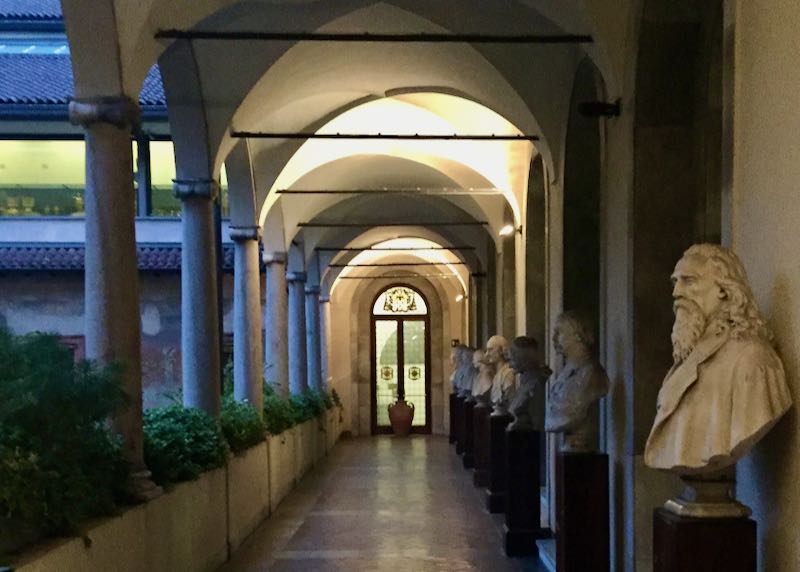
This quiet and humble gallery was founded in the early 17th Century and contains an impressive array of Italian Renaissance paintings, including Leonardo da Vinci’s Portrait of a Musician and Basket of Fruit by Caravaggio. It also houses the Biblioteca Ambrosiana, Milan’s oldest library. The building’s austere exterior keeps crowds away even though it’s only a quick 2-minute stroll from the mass of tourists in Piazza del Duomo, creating a peaceful respite for lovers of art and ancient literature.
The museum’s 24 rooms are arranged in a rough chronological fashion, jumping around a bit to keep you on your toes. Older works do tend to be in the original portion of the main building on the first floor, where Cardinal Federico Borromeo first consolidated his collection around 1618. From there the path winds through a maze of hallways, staircases, courtyards, and hidden doors to the big reveal at the end with Da Vinci’s masterpiece and a series of 16 sketches by the artist.
The library contains over 30,000 manuscripts and is a must-see for book lovers, however be aware that you will not actually be able to see many of them. A few samples are in display cases for viewing, but almost all the books in the library are arranged in high cubbies along the walls that used to have bars across them, which was an innovative practice in the 1600s.
The path through the 24 rooms takes a while to navigate; give yourself at least a couple of hours to take in. Note that the Pinacoteca is not well-designed for wheelchair users, however the first floor and the Codex Atlanticus (the room containing the Da Vinci works) are accessible. Open Tuesday to Sunday 10am-6pm, with last entry at 5:30pm. Closed Mondays. • Map
5. Cimitero Monumentale
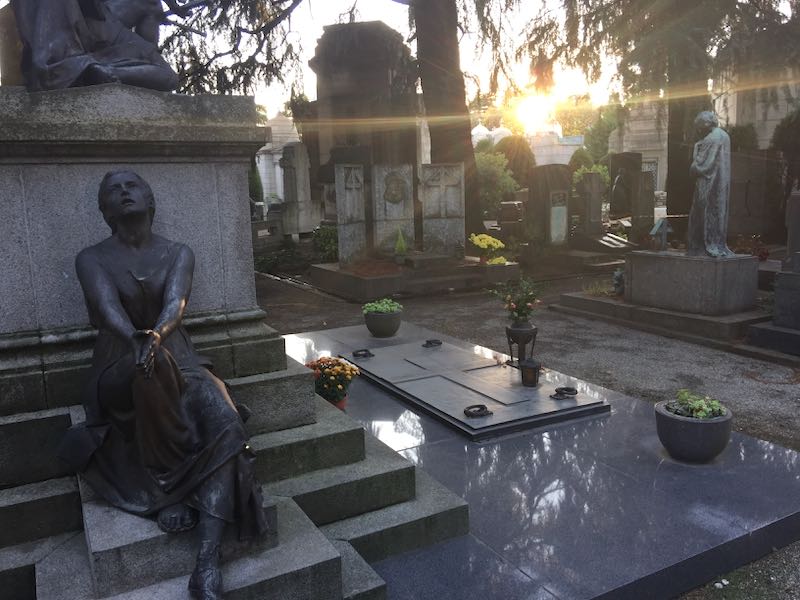
It’s not really a museum per se, but Cimitero Monumentale may as well be the Louvre when it comes to the amount of beautiful art it contains. Thousands of sculptures are spread across the cemetery’s 250,000 square meters. You can walk for hours and not see the same one twice as they keep their lonely vigils amid rows of beautifully somber crypts, temples, and mausoleums. The grounds are also peppered with intricate obelisks and columns, with mature trees and vegetation that provide a park-like setting.
To enter, you’ll first make your way through a massive gothic-inspired building that contains some of the cemetery’s more famous residents, including novelist Alessandro Manzoni. Most of the building is made up of medieval-flavored, open-air corridors lined with dramatic, grief-stricken figurines. The corridors eventually lead to the towering Civico Mausoleo Palanti in the center of the structure, a memorial for Milanese who were killed in Nazi concentration camps.
Hardly anyone makes the trip here, even though it’s only a 10-minute metro ride from the Duomo, so it’s often just you and the statues enjoying a quiet respite from the hustle and bustle of Milan. Many famous Italians are buried here, including the Camparini family (of the Campari spirits brand), so grab a map from the ticket office when you arrive. The cemetery also has a Jewish section on the east corner, with a separate entrance. It’s worth seeing both for its artistry and to remember the suffering of Italy’s Jewish population during World War II, including a monument for those killed in the massacre of Meina as depicted in the film Hotel Meina.
The cemetery is huge, and you will need at least 3-4 hours to see it all. Photographers especially will find many irresistible opportunities, so add another hour (at least) if you have time to linger. Admission is free. Be sure to get a map of the grounds at the tourism desk located in the large open square in front; you can also book a guided tour in advance. Open Tuesday to Sunday: 8am-6pm, with last entry at 5:30. Closed Mondays. • Map
More Great Milan Museums
- Museo Nazionale della Scienza e della Tecnologia (Science Museum): The largest science and technology museum in Italy features an exhibit devoted to concepts and drawings from Leonardo da Vinci. Tickets and hours: Adults €10, children and students under 26 €7,50. Open Tuesday to Friday 10am-6pm, Saturday and holidays 10am-7pm. Last admission 30 minutes before closing. Closed Mondays. • Map
- Fondazione Prada: Sleek and modern art museum designed by noted architect Rem Koolhaus and featuring a range of avant-garde exhibits including the “Haunted House” installation built within a former distillery. Tickets and hours: Adults €15, €10 for children and students under 26. Open Monday, Wednesday, Thursday 10am–5pm; Friday, Saturday, Sunday 10am–8pm; ticket desk remains open until one hour before closing. Closed Tuesdays. • Map
- Civico Museo Archeologico di Milano: The best collection of Roman artifacts in the city. Contains part of a medieval Roman wall as well as remains from towers dating to 1st-3rd Century AD. Tickets and hours: Adults €5, €3 for children under 18. Free entry after 2pm on the first and third Tuesday of the month. Open Tuesday to Sunday 9am–5:30pm; ticket office closes at 4:30pm. Closed Mondays. • Map
- Gallerie d’Italia: In a historic stately home, in the same piazza as La Scala, is this collection of the best 19th-century Lombardian art, with a fantastic selection of work by the ground-breaking futurist Umberto Boccioni. Closed on Mondays. • Map
- Museo del Novecento: Housed in the austere Palazzo Arengario, a fascist-era administrative building, the gallery’s expansive collection of 20th-century Italian art is almost overshadowed by the views of the Duomo from within. A Guggenheim-like spiral ramp leads up to the galleries and also the excellent Giacomo restaurant on the top floor. • Map
- Palazzo Reale: Italy’s complicated and fractured history is made a bit clearer by taking a tour of the ‘Royal Palace’, which helps visitors get to grips with the various rulers of this part of Italy (Spanish, French, Viscontis, Sforzas, Habsburgs, and others have all been in power at one time or another). The palace also hosts a range of temporary exhibitions. • Map
- Museo Poldi Pezzoli: A unique 19th-century private collection that became a public museum when Gian Giacomo Poldi Pezzoli died without an heir. Pezzoli curated his own home into a series of historically-themed rooms, with a fantastic collection of suits of armor, weapons, timepieces, and Renaissance fine art from the likes of Botticelli, Bellini, and Piero della Francesca. Closed Tuesdays. • Map
- Museo delle Culture: Mudec, as Milan’s cultural museum is known, not only has a varied ethnographic collection of thousands of fascinating objects from around the world (with a good kids’ area), but it also hosts world-class temporary art and design exhibitions. All this, in a David Chipperfield-designed, light-filled renovated factory that houses Enrico Bartolini’s Michelin-starred restaurant. • Map
Milan Museum Discounts
Those looking to enjoy many of Milan’s museums might consider a tourist pass, which offers a variety of discounts and “fast track” special entrance options, as well as deals on transportation and restaurants. There are three main options to choose from:
- Milan Pass: This pass lasts for 48 hours, and is a good option for those who are looking to pack a lot of sightseeing into a short window of time. It includes free entry to eight of Milan’s top attractions including the Duomo terraces and museum, and also the Brera Gallery. The pass also offers discounts on some fun non-museum options, like a 20% break on tickets to the Blue Note jazz club in Porta Nuevo. Prices are €69 for adults (12+) and €29 for kids 4-11. You can buy online, but you’ll need to pick up a voucher at the Milan Visitor Center near Sforza Castle before you can start using it.
- Visitalia Tourist Card: The Visitalia card can be purchased for 1-4 days (consecutive days only), and has great public transportation discounts to help you get around cheaply. It’s accepted at 10 different museums, and provides a variety of discount/free/fast entry options along with discounts at a number of restaurants, shopping, and entertainment venues. It’s also the cheapest of the lot, with passes available for €8 for one day, €10 for two, €13 for three, and €14 for four (prices are the same for all ages). Available online and at several tourist desks located at Malpenza airport, Stazione Centrale, and Linate Airport.
- Milano Card: Another card for those who can pack a lot into a little bit of time, the card is available in 1-3 day increments. It actually pays for itself pretty quickly on public transportation alone; the pass operates as a slightly more expensive ATM (public transit) card, which provides free travel on trams, buses, and the metro. It also has the broadest selection of discounted museums, with over 30 different possibilities to choose from (although the card doesn’t offer as many free entrances and discounts as the other two). To get the most out of it, you’ll want to buy a Tourist “Museum Card” as an optional add-on (it will cost you another €10). If you’re planning to get out to the Lake District (Como, Maggiore, or Garda), this pass will give you a 20% break on cruises. Your options are for a 1-day pass at €7, a 3-day pass at €13 with 2 days free public transport, or a 3-day pass for €19 with 3 days free public transport (passes are for all age groups). Available online and at several tourist desks located at Malpenza airport, Stazione Centrale, and Linate Airport.
About Santorini Dave